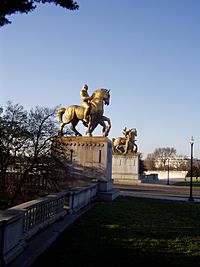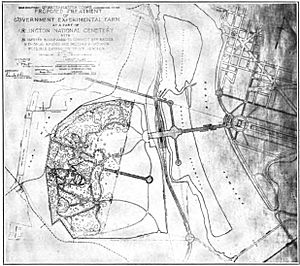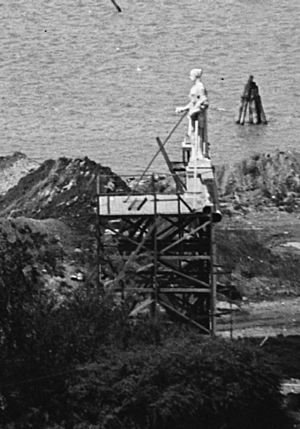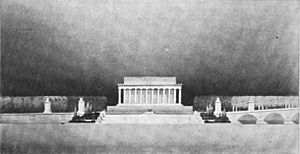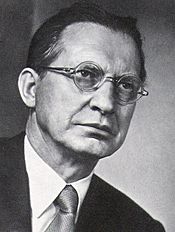The Arts of War and The Arts of Peace facts for kids
The Arts of War and The Arts of Peace are large, golden bronze statues in Washington, D.C.. They stand near the Lincoln Memorial in West Potomac Park. These statues were ordered in 1929 to make the area around the Lincoln Memorial and the Arlington Memorial Bridge look grand. However, they weren't finished until 1939 due to money problems. The actual statues were cast in 1950 and put up in 1951.
Leo Friedlander, an American sculptor, created The Arts of War. This group has two parts: Valor and Sacrifice. They stand at the entrance to the Arlington Memorial Bridge.
James Earle Fraser, another American sculptor, made The Arts of Peace. This group also has two parts: Music and Harvest and Aspiration and Literature. They are located at the entrance to the Rock Creek and Potomac Parkway.
Both statue groups are important parts of the East and West Potomac Parks Historic District. This area was added to the National Register of Historic Places in 1973.
Building Bridges and Parkways
For a long time, people in Washington, D.C., wanted a new bridge across the Potomac River. Ideas for a bridge were suggested in 1886 and 1898, but nothing was built.
A new area for a bridge became available in 1890. After big floods in 1881, Congress decided to make the Potomac River deeper. The dirt removed from the river was used to create new land in West Potomac Park. This new land, along with a new island called Columbia Island, made it possible to build a bridge further south.
In 1902, a group called the Senate Park Commission suggested building a bridge from West Potomac Park to Arlington National Cemetery. This bridge would line up with Arlington House. It was meant to be a symbol of the country coming together after the American Civil War.
It took 12 years for Congress to act on this idea. Finally, in 1913, they created a commission to design the bridge. But World War I started, and no money was given, so the commission couldn't do anything.
The McMillan Plan also suggested building parkways, which are special roads through parks. One of these was the Rock Creek and Potomac Parkway. Construction on this parkway began in 1923.
Congress finally approved building the Arlington Memorial Bridge in 1925. A huge traffic jam during a ceremony in 1921 showed everyone how badly a new bridge was needed. In 1923, the architectural firm McKim, Mead and White was chosen to design the bridge. William Mitchell Kendall was the main designer.
Designing the Bridge's Entrances
The United States Commission of Fine Arts (CFA) had to approve the bridge's design. Kendall's first design for the eastern entrance included a plaza and steps leading to the river. He also planned for the Rock Creek and Potomac Parkway to go through this plaza. The CFA liked the bridge design but waited to approve the entrance plans.
In 1925, Congress approved the construction of the bridge.
Changes to the Entrance Plans
The bridge planners wanted the entrances to be grand and fitting for a memorial. By 1925, some changes were made to Kendall's plan. Two tall, square pillars (called pylons) were added at the bridge's entrance. These pylons would have images showing national unity. They also planned to widen B Street NW to make it a grand avenue leading to the bridge.
However, by 1928, the CFA worried that the tall pylons would block the view of the Lincoln Memorial. They even put up life-size photos of the pylons to see how they looked. They decided the pylons were too tall. Then, they tried life-size photos of horse statues, which looked much better. In December 1928, the CFA decided to replace the pylons with equestrian (horse and rider) statues.
Creating the Statues
Choosing the Sculptors
James Earle Fraser and Leo Friedlander were chosen to create the sculptures for the eastern entrance. It's not entirely clear how they were picked, but some reports say there was a competition in 1929. Other reports suggest they were directly chosen.
Getting Approval for the Designs
To get approval, sculptors had to make four different sizes of their statues out of plaster. These models were 1/16th, 3/16th, half, and full size. By June 1929, some early designs were ready. The CFA discussed the horse statues in December 1929, and Kendall finally agreed to remove his pylons.
By 1930, Friedlander and Fraser were working with the Army Corps of Engineers. They planned where the statues would go and how tall their bases (pedestals) would be.
In July 1930, the CFA approved the designs for the horse statues again. This likely meant they could start making the 3/16th size models.
In December 1930, the CFA approved more models. Friedlander's two groups were first called Valor and Call to Arms, but Call to Arms was later renamed Sacrifice. These two groups would stand at the entrance to the Arlington Memorial Bridge and were known as The Arts of War. They were made in the Art Deco style.
Fraser's two groups were named Music and Harvest and Aspiration and Literature. These would be at the entrance to the Rock Creek and Potomac Parkway and were called The Arts of Peace. They were in the Neoclassical style.
Money Problems and Delays
More plans for the statue groups were discussed in January 1931. Life-size photo mock-ups of the statues were viewed on site in July 1931.
By 1932, the CFA was impressed with the sculptors' progress. They visited Fraser's studio and approved his models.
However, in 1933, the project was put on hold. The United States was in the middle of the Great Depression. The bridge was finished and over budget, and there wasn't enough money for the expensive statues. Even though funds were tight, the CFA wanted the sculptors to finish their full-size models, which had already been paid for. They visited Friedlander's studio and approved his models in October 1933.
The CFA also decided on the statues' sizes. Each statue would be 16 feet tall. Their pedestals would be 13 feet tall, and a base (plinth) beneath the statues would be 1 foot tall.
Changing from Granite to Bronze
Because of the money problems, Fraser and Friedlander worked slowly. Funds for the statues were secured in 1935 but then taken away. Efforts to get money from Congress in 1937, 1938, and 1939 also failed. The sculptors finished their full-size plaster models in 1939.
In 1940, the CFA tried again to get money. The cost to carve the statues from granite was too high. James Earle Fraser then suggested making the statues from bronze instead. Friedlander and the CFA agreed. In 1941, both sculptors signed contracts to change their designs for bronze casting. For Friedlander, this meant going back to his original design without the heavy supports needed for granite.
Work on the statues stopped during World War II because bronze was needed for the war effort.
Finding a Foundry
In 1946, officials inspected Friedlander's revised model, and it was approved. But the cost of casting in bronze had almost doubled after the war. The National Park Service decided to store the models until prices were lower. In 1947, Fraser looked for foundries in Europe. One foundry said it would cost $212,000 to cast both of his statues. The statues were approved again in October 1947.
In 1948, the National Park Service found about $1 million available for the bridge project. They asked Congress for $185,000 to start casting the statues, but the bill didn't pass. Members of Congress suggested asking a European country to cast the statues as part of the Marshall Plan, which was a plan to help rebuild Europe after the war.
In February 1950, the CFA discussed the height of the pedestals again. They decided not to change the height after viewing life-size outlines of the statues on site.
Casting in Italy
In 1949, the government of Italy offered to use Marshall Plan funds to cast the four statues. In October, officials and the sculptors traveled to Italy to find foundries.
An agreement was made, and casting began in 1950. The plaster models arrived in Italy in January. Unfortunately, customs officials didn't know how to care for them, and the plaster statues were left outside in the cold and rain. Fraser's student, Edward Minazolli, went to Italy and found the models had been damaged. He carefully repaired them.
The A. Bruni Foundry in Rome and the Fonderia Lagana in Naples cast the sculptures using a method called lost-wax casting. They planned to make the statues golden using a process called fire-gilding. This involves applying gold and mercury to the bronze and then heating it. However, there were problems with both the casting and the gilding. The sculptors had to step in to ensure the quality was high. Samples of the gilded bronze sent to the U.S. were too bright, so the sculptors had to adjust the color.
In the end, the gilding for Valor was done in Milan, and Sacrifice in Florence. The Rome foundry did both casting and gilding for Aspiration and Literature, while Naples did both for Music and Harvest. More than 100 pounds of 24-karat gold were used!
Dedication Ceremony
The four statue groups were finished in April 1951. They were shown at several Italian fairs before being shipped to the United States. When Valor was moved through Milan, huge crowds cheered, "The Renaissance has returned!" The statues were brought by ship to Norfolk, Virginia, and then by barge up the Potomac River to Washington, D.C.
The statues were officially dedicated on September 26, 1951. The United States Army Band and opera singer Ezio Pinza performed. Secretary of the Interior Oscar L. Chapman led the event. Secretary of State Dean Acheson introduced the Prime Minister of Italy, Alcide De Gasperi. The Prime Minister offered the statues as a gift from the Italian people, thanking America for helping Italy rebuild after World War II. President Harry S. Truman accepted the gift.
Understanding the Statues
The Arts of War has two statue groups: Valor and Sacrifice. They are in an Art Deco style. If you face the Arlington Memorial Bridge from the Lincoln Memorial, Valor is on the left and Sacrifice is on the right. Valor shows a strong, bearded man, like Mars, the Roman god of war. A woman with a shield is next to him. Sacrifice shows the same figures but in different poses. The man holds a small child, and the woman looks back at him.
The Arts of Peace (also called The Peaceful Arts) also has two statue groups: Music and Harvest and Aspiration and Literature. They are in a Neoclassical style. If you face the Rock Creek Parkway from the Lincoln Memorial traffic circle, Aspiration and Literature is on the left and Music and Harvest is on the right. Pegasus, the mythical winged horse, is the main part of both groups. Aspiration and Literature shows a man with a book (for literature) and another man aiming a bow (for aspiration). A snake behind the literature figure means wisdom. Music and Harvest shows a man with a sickle and wheat (for harvest) and a woman with a harp (for music). A turtle behind the woman symbolizes that "art is long and time is fleeting."
Each statue group weighs about 80,000 pounds. They are 19 feet high, 16 feet long, and 8 feet wide. The parts of Sacrifice and Valor were welded together. Music and Harvest and Aspiration and Literature were bolted together. The total cost for moving, casting, and gilding all four groups was $300,000.
Each granite pedestal (base) is hollow. The statues were originally attached to their pedestals with a steel frame. Each pedestal has 36 golden bronze stars at the top. These stars represent the number of states in the U.S. during the Civil War. At the front of each pedestal is a classical wreath.
You can enter Valor through a hatch in the horse's rear for maintenance. The other three statues are accessed through hatches in the top of their pedestals.
Repairs Over the Years
By 1970, all four statues needed major repairs. Much of the gold finish was peeling off, and there were many cracks and holes. The two Fraser statues were in especially bad shape. The National Bureau of Standards suggested several ways to fix them.
The National Park Service decided to re-gild the statues using a method called brush electroplating. Workers found that water was building up inside the hollow statues. This was because the pedestals were open to the earth, and the statues weren't sealed well to their bases. This moisture caused a lot of rust (corrosion) inside the statues. The steel bolts holding the statues together were so rusted that some had almost fallen apart. Workers believed the statues were close to collapsing! The problem was made worse by gypsum (a material used for molds) left inside two of the statues.
To fix this, the steel bolts and supports were replaced with bronze parts. As much gypsum as possible was cleaned out. More than 1,000 brass bolts were used in two of the statues alone.
The steel anchors holding the statues to the pedestals were also in bad condition. They were replaced with brass frames.
The bronze castings themselves had problems, too. Several pieces had cracked, some severely. Music and Harvest had a 6.6-foot-long crack. Welding didn't work well, so cracks were filled with a special solder. Where cracks were wide, metal straps were added inside.
Another problem was pitting, which are small holes in the bronze. After the old gilding was removed, the statues were covered in pits. The two Fraser statues had the worst casting quality. The bronze was also porous, letting water seep in and cause more rust. The holes and deepest pits were drilled out and filled. Since hundreds of small pits couldn't be repaired, a special nickel coating was applied, followed by a gold coating. A protective lacquer was then put on the entire surface.
The restoration of Music and Harvest and Aspiration and Literature happened in late 1971. Valor and Sacrifice were restored starting in November 1972. Each pair of statues took 60 days to repair and re-gild.
After the statues were put back, some discoloration appeared. It was from leftover cleaning solution, which was washed off. Later inspections showed only very small spots of rust, which were cleaned and re-lacquered. After 1974, the repairs seemed to work well.
Although the statues looked a little darker and shinier because of the lacquer, the Commission of Fine Arts was happy with the results.
Later Repairs
In 1984, another company worked on restoring The Arts of War and The Arts of Peace.
Around 1985, the pedestal of the Valor statue was spray-painted. The National Park Service tried to remove the paint, but it didn't work. In 2005, they tried a different chemical, which also failed and left purple streaks. An art restorer suggested using a laser, but the laser couldn't remove the purple stain.


